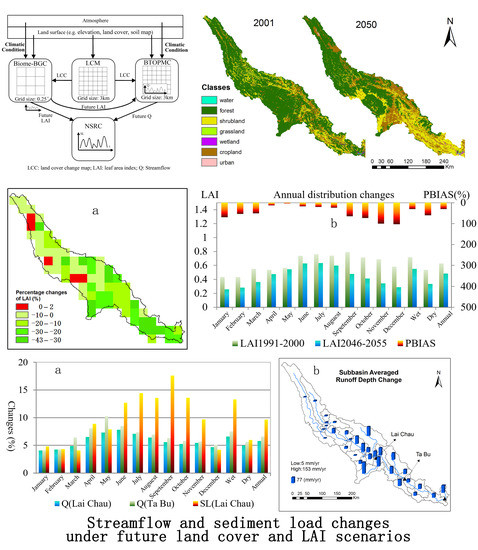Modeling Hydrological Appraisal of Potential Land Cover Change and Vegetation Dynamics under Environmental Changes in a Forest Basin
Abstract
1. Introduction
2. Study Area and Data Description
2.1. Study Area Description
2.2. Dataset Description
3. Methodology
3.1. Land Cover Change Model
3.2. Ecological Model (Biome-BGC)
3.3. Hydrological Model (BTOPMC)
- (i)
- Nash-Sutcliffe efficiency (NSE): NSE ranges between −∞ and 1.0 (1 inclusive), with NSE = 1 being the optimal value. Values between 0.0 and 1.0 are generally viewed as being at a satisfactory performance level:
- (ii)
- The ratio of the root mean squared error to the observations standard deviation (RSR): RSR varies from the optimal value of 0, which indicates perfect performance in the simulation, to a large positive value. A lower RSR represents better the model simulation performance:
- (iii)
- Percent bias (PBIAS): The PBIAS value should be close to zero. Positive values indicate the model contains underestimation bias and vice versa:where Qsim is the simulated value, Qobs is the observed value, is the average simulated value, and is the average observed value.
3.4. New Sediment Rating Curve (NSRC)
4. Results
4.1. Future Land Cover Change Prediction
4.2. Future LAI Predictions
4.3. Hydrological Model and NSRC Model Simulation
4.4. Future Land Cover Change Impacts on Streamflow and Sediment Load
4.5. Discussion
4.5.1. Combination of Future Land Cover and LAI Changes
4.5.2. Impacts of Forest Cover Changes on Streamflow
4.5.3. Impacts of Increased Sediment Load on Reservoir Lifetime
4.5.4. Uncertainties Analysis
5. Conclusions
Author Contributions
Funding
Acknowledgments
Conflicts of Interest
Abbreviations
| DRB | Da River Basin |
| LCM | Land Change Model |
| Biome-BGC | Biome-BioGeochemical Cycle Model |
| BTOPMC | Block wise use of TOPMODEL with Muskingum–Cunge routing model |
| NSRC | New Sediment Rating Curve |
| SSC | Suspended Sediment Concentration |
| SL | Sediment Load |
| LAI | Leaf Area Index |
| LC | Lai Chau |
| TB | Ta Bu |
References
- Gashaw, T.; Tulu, T.; Argaw, M.; Worqlul, A.W. Modeling the hydrological impacts of land use/land cover changes in the Andassa watershed, Blue Nile Basin, Ethiopia. Sci. Total Environ. 2018, 619–620, 1394–1408. [Google Scholar] [CrossRef] [PubMed]
- Zhang, L.; Hickel, K.; Shao, Q.X. Predicting afforestation impacts on monthly streamflow using the DWBM model. Ecohydrology 2017, 10. [Google Scholar] [CrossRef]
- Wiekenkamp, I.; Huisman, J.A.; Bogena, H.R.; Graf, A.; Lin, H.S.; Drüe, C.; Vereecken, H. Changes in measured spatiotemporal patterns of hydrological response after partial deforestation in a headwater catchment. J. Hydrol. 2016, 542, 648–661. [Google Scholar] [CrossRef]
- Sun, S.L.; Chen, H.S.; Ju, W.M.; Hua, W.J.; Yu, M.; Yin, Y.X. On the attribution of changing hydrological cycle in Poyang Lake Basin, China. J. Hydrol. 2014, 514, 214–225. [Google Scholar] [CrossRef]
- Liu, Y.B.; Xiao, J.F.; Ju, W.M.; Xu, K.; Zhou, Y.L.; Zhao, Y.T. Recent trends in vegetation greenness in China significantly altered annual evapotranspiration and water yield. Environ. Res. Lett. 2016, 11, 094010. [Google Scholar] [CrossRef]
- Schmidt, A.H.; Gonzalez, V.S.; Bierman, P.R.; Thomas, B.N.; Dylan, H.R. Agricultural land use doubled sediment loads in western China’s rivers. Anthropocene 2017, 21, 95–106. [Google Scholar] [CrossRef]
- Ward, P.J.; Renssen, H.; Aerts, J.C.J.H.; Van Balen, R.T.; Vandenberghe, J. Strong increases in flood frequency and discharge of the River Meuse over the late Holocene: Impacts of long-term anthropogenic land use change and climate variability. Hydrol. Earth Syst. Sci. 2008, 12, 159–175. [Google Scholar] [CrossRef]
- Doyle, M.; Harbor, J.; Rich, C.; Spacie, A. Examining the effects of urbanization on streams using indicators of geomorphic stability. Phys. Geogr. 2000, 21, 155–181. [Google Scholar]
- Garcia-Ruiz, J.M.; Lana-Renault, N. Hydrological and erosive consequences of farmland abandonment in Europe, with special reference to the Mediterranean region—A review. Agric. Ecosyst. Environ. 2011, 140, 317–338. [Google Scholar] [CrossRef]
- Costa, M.H.; Botta, A.; Cardille, J.A. Effects of large-scale changes in land cover on the discharge of the Tocantins Rivers, Southeastern Amazonia. J. Hydrol. 2003, 283, 206–217. [Google Scholar] [CrossRef]
- Wardrop, D.H.; Brooks, R.P. The Occurrence and impact of sedimentation in central Pennsylvania wetlands. Environ. Monit. Assess. 1998, 51, 119–130. [Google Scholar] [CrossRef]
- María, J.M.; Ramón, B.; Luis, J.; Raquel, P. Effect of vegetal cover on runoff and soil erosion under light intensity events. Rainfall simulation over USLE. Sci. Total Environ. 2007, 378, 161–165. [Google Scholar]
- Leh, M.; Bajwa, S.; Chaubey, I. Impact of land use change on erosion risk: An integrated remote sensing, geographic information system and modeling methodology. Land Degrad. Dev. 2013, 24, 409–421. [Google Scholar] [CrossRef]
- Zhou, G.X.; Wei, X.; Luo, Y.; Zhang, M.; Li, Y.; Qiao, Y.; Liu, H.G.; Wang, C.L. Forest recovery and river discharge at the regional scale of Guangdong province, China. Water Resour. Res. 2010, 46, w09503. [Google Scholar] [CrossRef]
- Wang, S.; Fu, B.J.; He, C.S.; Sun, G.; Gao, G.Y. A comparative analysis of forest cover and catchment water yield relationships in northern China. For. Ecol. Manag. 2011, 262, 1189–1198. [Google Scholar] [CrossRef]
- Zhou, G.; Wei, X.; Chen, X.; Zhou, P.; Liu, X.; Xiao, Y. Global pattern for the effect of climate and land cover on water yield. Nat. Commun. 2015, 6, 5918. [Google Scholar] [CrossRef] [PubMed]
- Tang, L.H.; Yang, D.W.; Hu, H.P.; Gao, B. Detecting the effect of land-use change on streamflow, sediment and nutrient losses by distributed hydrological simulation. J. Hydrol. 2011, 409, 172–182. [Google Scholar] [CrossRef]
- Dao, N.K.; Suetsugi, T. The responses of hydrological processes and sediment yield to land-use and climate change in the Be River Catchment, Vietnam. Hydrol. Process. 2014, 28, 640–652. [Google Scholar]
- Zorzal-Almeida, S.; Salim, A.; Andrade, M.R.M.; Nascimento, M.N.; Bini, L.M.; Bicudo, D.C. Effects of land use and spatial processes in water and surface sediment of tropical reservoirs at local and regional scales. Sci. Total Environ. 2018, 644, 237–246. [Google Scholar] [CrossRef] [PubMed]
- Gao, G.Y.; Fu, B.J.; Zhang, J.J.; Ma, Y.; Sivapalan, M. Multiscale temporal variability of flow-sediment relationships during the 1950s–2014 in the loess plateau, china. J. Hydrol. 2018, 563, 609–619. [Google Scholar] [CrossRef]
- Wang, J.; Ishidaira, H.; Ning, S.; Khujanazarov, T.; Yin, G.; Guo, L. Attribution Analyses of Impacts of Environmental Changes on Streamflow and Sediment Load in a Mountainous Basin, Vietnam. Forests 2016, 7, 30. [Google Scholar] [CrossRef]
- Kellner, E.; Hubbart, J.A. Improving understanding of mixed-land-use watershed suspended sediment regimes: Mechanistic progress through high-frequency sampling. Sci. Total Environ. 2017, 598, 228–238. [Google Scholar] [CrossRef] [PubMed]
- Le, T.P.Q.; Garnier, J.; Gilles, B.; Sylvain, T.; Van, M.C. The changing flow regime and sediment load of the Red River, VietNam. J. Hydrol. 2007, 334, 199–214. [Google Scholar] [CrossRef]
- Wang, J.; Ishidaira, H. Effects of human-induced vegetation cover change on sediment flow using satellite observations and terrestrial ecosystem model. J. Jpn. Soc. Civ. Eng. Ser. B1 2013, 69, I_205–I_210. [Google Scholar] [CrossRef]
- Dang, T.H.; Coynel, A.; Orange, D.; Blanc, G.; Etcheber, H.; Le, L.A. Long-term monitoring (1960–2008) of the river-sediment transport in the Red River Watershed (Vietnam): Temporal variability and dam-reservoir impact. Sci. Total Environ. 2010, 408, 4654–4664. [Google Scholar] [CrossRef] [PubMed]
- Imhof, A. Vietnam dam to cause hardship for ethnic minorities. World Rivers Rev. 1998, 13, 3–4. [Google Scholar]
- Verburg, P.H.; Soepboer, W.; Veldkamp, A.; Limpiada, R.; Espaldon, V.; Mastura, S.S. Modeling the spatial dynamics of regional land use: The CLUE-S model. Environ. Manag. 2002, 30, 391–405. [Google Scholar] [CrossRef] [PubMed]
- Soares, B.S.; Cerqueira, G.C.; Pennachin, C.L. DINAMICA—A stochastic cellular automata model designed to simulate the landscape dynamics in an Amazonian colonization frontier. Ecol. Model. 2002, 154, 217–235. [Google Scholar] [CrossRef]
- Pontius, R.G.; Cornell, J.D.; Hall, C.A.S. Modeling the spatial pattern of land-use change with GEOMOD2: Application and validation for Costa Rica. Agric. Ecosyst. Environ. 2001, 85, 191–203. [Google Scholar] [CrossRef]
- Kim, O.S. An assessment of deforestation models for reducing emissions from deforestation and forest degradation (REDD). Trans. GIS 2010, 14, 631–654. [Google Scholar] [CrossRef]
- Azucena, P.V.; Mas, J.F.; Arika, L.Z. Comparing two approaches to land use/cover change modeling and their implications for the assessment of biodiversity loss in a deciduous tropical forest. Environ. Model. Softw. 2011, 29, 11–23. [Google Scholar]
- Lin, Y.P.; Hong, N.M.; Wu, P.J.; Lin, C.J. Modeling and assessing land-use and hydrological processes to future land-use and climate change scenarios in watershed land-use planning. Environ. Geol. 2007, 53, 623–634. [Google Scholar] [CrossRef]
- Romano, G.; Abdelwahab, O.M.M.; Gentile, F. Modeling land use changes and their impact on sediment load in a Mediterranean watershed. Catena 2018, 163, 342–353. [Google Scholar] [CrossRef]
- Xiao, J.F.; Zhou, Y.; Zhang, L. Contributions of natural and human factors to increases in vegetation productivity in China. Ecosphere 2016, 6, 1–20. [Google Scholar] [CrossRef]
- United Nations Environment Programme (UNEP). China Conservation Strategy; UNEP & China Environmental Science Press: Beijing, China, 1990. [Google Scholar]
- Ye, C.Q.; Gan, S.; Wang, W.L.; Deng, Q.Y.; Chen, W.H.; Li, Y.G. Analysis on the runoff distribution and the variability in the downstream of Honghe River. Resour. Environ. Yangtze Basin 2008, 17, 886–891. [Google Scholar]
- World Bank. Vietnam Water Resources Sector Review: Selected Working Papers of the World Bank, ADB, FAO/UNP and NGO Water Resources Sectoral Group; World Bank Group: Hanoi, Vietnam, 1996; p. 340. [Google Scholar]
- Forest Science Institute of Vietnam (FSIV). Vietnam Forestry Outlook Study, Asia-Pacific Forestry Sector Outlook Study II; Working Paper Series; Forest Science Institute of Vietnam: Hanoi, Vietnam, 2009. [Google Scholar]
- Li, X.; Cheng, G.; Lu, L. Spatial analysis of air temperature in the Qinghai-Tibet Plateau. Arct. Antarct. Alp. Res. 2005, 37, 246–252. [Google Scholar] [CrossRef]
- Mahdian, M.H.; Bandarabady, S.R.; Sokouti, R.; Banis, Y.N. Appraisal of the geostatistical methods to estimate monthly and annual temperature. J. Appl. Sci. 2009, 9, 128–134. [Google Scholar] [CrossRef]
- Available online: https://lta.cr.usgs.gov/GTOPO30 (accessed on 16 May 2017).
- Available online: http://www.fao.org/geonetwork/srv/en/metadata.show?id=14116 (accessed on 15 December 2017).
- Available online: https://lpdaac.usgs.gov/products/modis_products_table/mcd12q1 (accessed on 10 June 2017).
- Zhu, Z.C.; Bi, J.; Pan, Y.Z.; Ganguly, S.; Anav, A.; Xu, L.; Samanta, A.; Piao, S.L.; Nemani, R.R.; Myneni, R.B. Global Data Sets of Vegetation Leaf Area Index (LAI) 3g and Fraction of Photosynthetically Active Radiation (FPAR) 3g Derived from Global Inventory Modeling and Mapping Studies (GIMMS) Normalized Difference Vegetation Index (NDVI3g) for the Period 1981 to 2011. Remote Sens. 2013, 5, 927–948. [Google Scholar]
- Clark Labs. The Land Change Modeler for Ecological Sustainability; IDRISI Focus Paper; Clark University: Worcester, MA, USA, 2009. [Google Scholar]
- Oñate-Valdivieso, F.; Sendra, J.B. Application of GIS and remote sensing techniques in generation of land use scenarios for hydrological modeling. J. Hydrol. 2010, 395, 256–263. [Google Scholar] [CrossRef]
- Eastman, J.R. IDRISI Andes Tutorial; Clark-Labs, Clark University: Worcester, MA, USA, 2006. [Google Scholar]
- Monserud, R.A.; Leemans, R. Comparing global vegetation maps with the Kappa statistic. Ecol. Model. 1992, 62, 275–293. [Google Scholar] [CrossRef]
- Running, S.W.; Gower, S.T. FOREST-BGC, A general model of forest ecosystem processes for regional applications. Tree Physiol. 1991, 9, 147–160. [Google Scholar] [CrossRef] [PubMed]
- Ichii, K.; Hashimoto, H.; Nemani, R.; White, M. Modeling the interannual variability and trends in gross and net primary productivity of tropical forests from 1982 to 1999. Glob. Planet. Chang. 2005, 48, 274–286. [Google Scholar] [CrossRef]
- Takeuchi, K.; Ao, T.Q.; Ishidaira, H. Introduction of blockwise use of TOPMODEL and Muskingum–Cunge method for the hydro-environmental simulation of a large ungauged catchment. Hydrol. Sci. J. 1999, 44, 633–646. [Google Scholar] [CrossRef]
- Ishidaira, H.; Takeuchi, K.; Ao, T. Hydrological simulation of large river basins in Southeast Asia. In Proceedings of the Fresh Perspectives on Hydrology and Water Resources in Southeast Asia and the Pacific, Christchurch, New Zealand, 21–24 November 2000; pp. 53–54. [Google Scholar]
- Beven, K. Linking parameters across scales-sub grid parameterizations and scale-dependent hydrological models. Hydrol. Process. 1995, 9, 507–525. [Google Scholar] [CrossRef]
- Shrestha, S.; Bastola, S.; Babel, M.S.; Dulal, K.N.; Magome, J.; Hapuarachchi, H.A.P.; Kazama, F.; Ishidaira, H.; Takeuchi, K. The assessment of spatial and temporal transferability of a physically based distributed hydrological model parameters in different physiographic regions of Nepal. J. Hydrol. 2007, 347, 153–172. [Google Scholar] [CrossRef]
- Moriasi, D.N.; Arnold, J.G.; Van Liew, M.W.; Bingner, R.L.; Harmel, R.D.; Veith, T.L. Model evaluation guidelines for systematic quantification of accuracy in watershed simulations. Trans. ASABE 2007, 50, 885–900. [Google Scholar] [CrossRef]
- Asselman, N.E.M. Fitting and interpretation of sediment rating curves. J. Hydrol. 2000, 234, 228–248. [Google Scholar] [CrossRef]
- Howe, A.; Rodriguez, J.; MacFarlane, G. Vegetation Sediment Flow Interactions in Estuarine Wetlands. In Proceedings of the International Congress on Modelling and Simulation (MODSIM05), Melbourne, Australia, 12–15 December 2005; pp. 332–338. [Google Scholar]
- Wang, J.; Ishidaira, H.; Sun, W.C.; Ning, S.W. Development and Interpretation of New Sediment Rating Curve Considering the Effect of Vegetation Cover for Asian Basins. Sci. World J. 2013, 2013, 154375. [Google Scholar] [CrossRef] [PubMed]
- Aguejdad, R.; Houet, T.; Hubert-Moy, L. Spatial Validation of Land Use Change Models Using Multiple Assessment Techniques: A Case Study of Transition Potential Models. Environ. Model. Assess. 2017, 22, 591–606. [Google Scholar] [CrossRef]
- Panday, P.K.; Coe, M.T.; Macedo, M.N.; Lefebvre, P.; Castanho, A.D.D.A. Deforestation offsets water balance changes due to climate variability in the Xingu river in Eastern Amazonia. J. Hydrol. 2015, 523, 822–829. [Google Scholar] [CrossRef]
- Alvarenga, L.A.; Mello, C.R.D.; Colombo, A.; Cuartas, L.A.; Bowling, L.C. Assessment of land cover change on the hydrology of a brazilian headwater watershed using the distributed hydrology-soil-vegetation model. Catena 2016, 143, 7–17. [Google Scholar] [CrossRef]
- Coe, M.T.; Costa, M.H.; Soares-Filho, B.S. The influence of historical and potential future deforestation on the stream flow of the Amazon River—Land surface processes and atmospheric feedbacks. J. Hydrol. 2009, 369, 165–174. [Google Scholar] [CrossRef]
- Zhao, J.; Xu, Z.X.; Singh, V.P. Estimation of root zone storage capacity at the catchment scale using improved Mass Curve Technique. J. Hydrol. 2016, 540, 959–972. [Google Scholar] [CrossRef]
- Sanyal, J.; Densmore, A.L.; Carbonneau, P. Analysing the effect of land-use/cover changes at sub-catchment levels on downstream flood peaks: A semi-distributed modelling approach with sparse data. Catena 2014, 118, 28–40. [Google Scholar] [CrossRef]
- Dudgeon, D.; Choowaew, S.; Ho, S.C. River conservation in South-East Asia. In Global Perspectives on River Conservation: Science, Policy and Practice; Boon, P.J., Davies, B.R., Petts, G.E., Eds.; John Wiley & Sons Ltd.: Chichester, UK, 2000; pp. 279–308. [Google Scholar]
- Maneux, E.; Probst, J.L.; Veyssy, E.; Etcheber, H. Assessment of dam trapping efficiency from water residence time: Application to fluvial sediment transport in the Adour, Dordogne, and Garonne River basins (France). Water Resour. Res. 2001, 37, 801–811. [Google Scholar] [CrossRef]
- Vörösmarty, C.J.; Meybeck, M.; Fekete, B.; Sharma, K.; Green, P.; Syvitski, J.P.M. Anthropogenic sediment retention: Major global impact from registered river impoundments. Glob. Planet. Chang. 2003, 39, 169–190. [Google Scholar] [CrossRef]

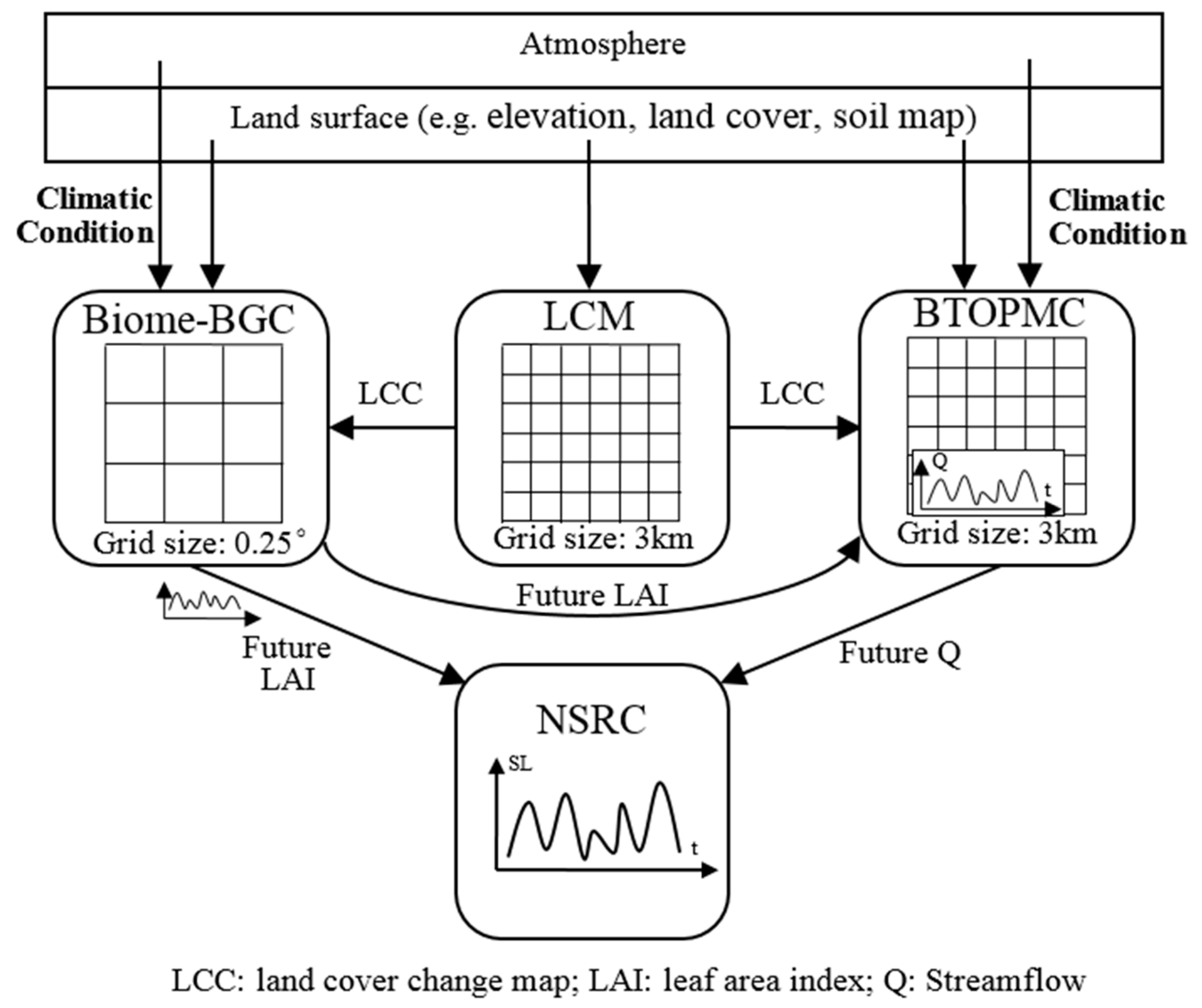
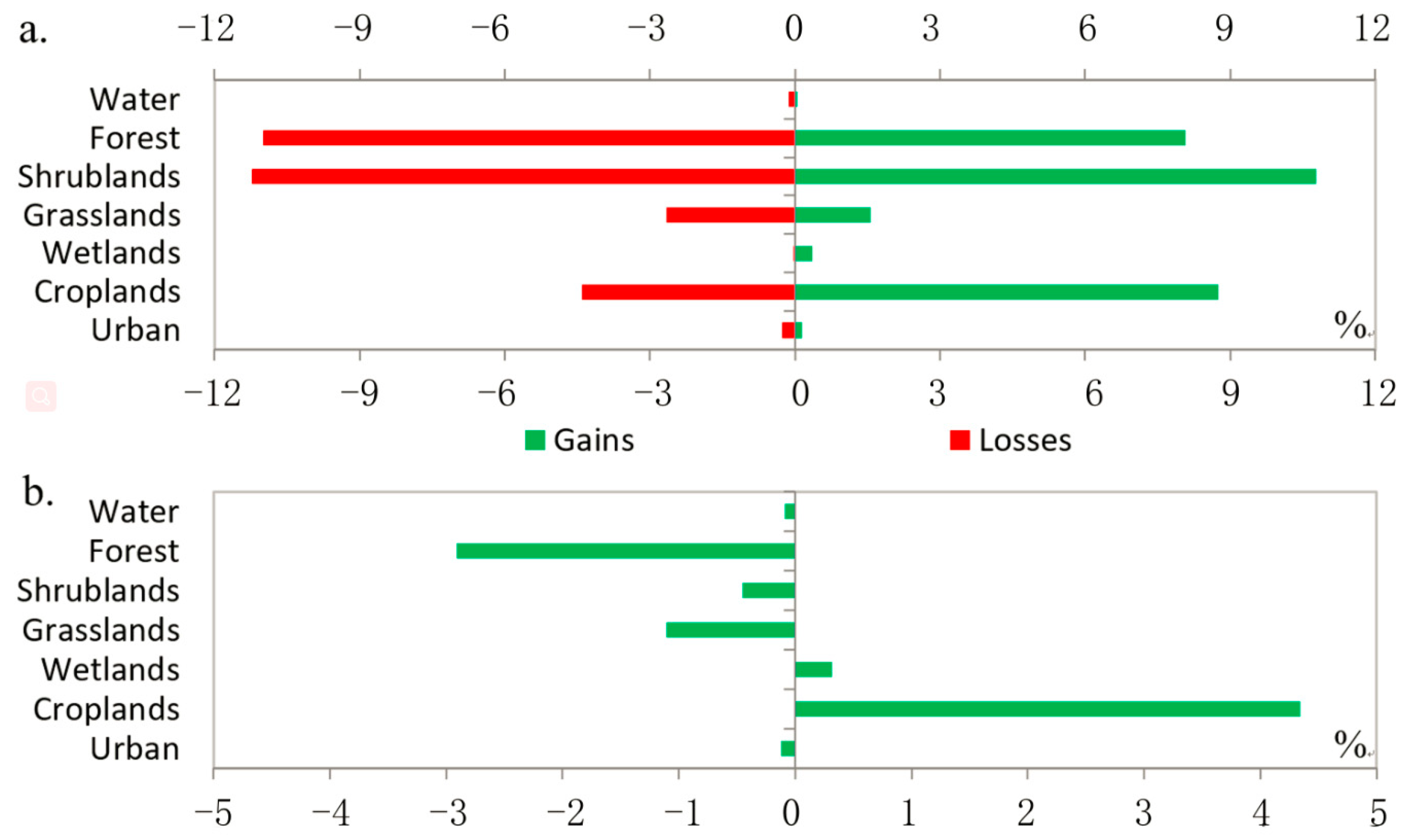
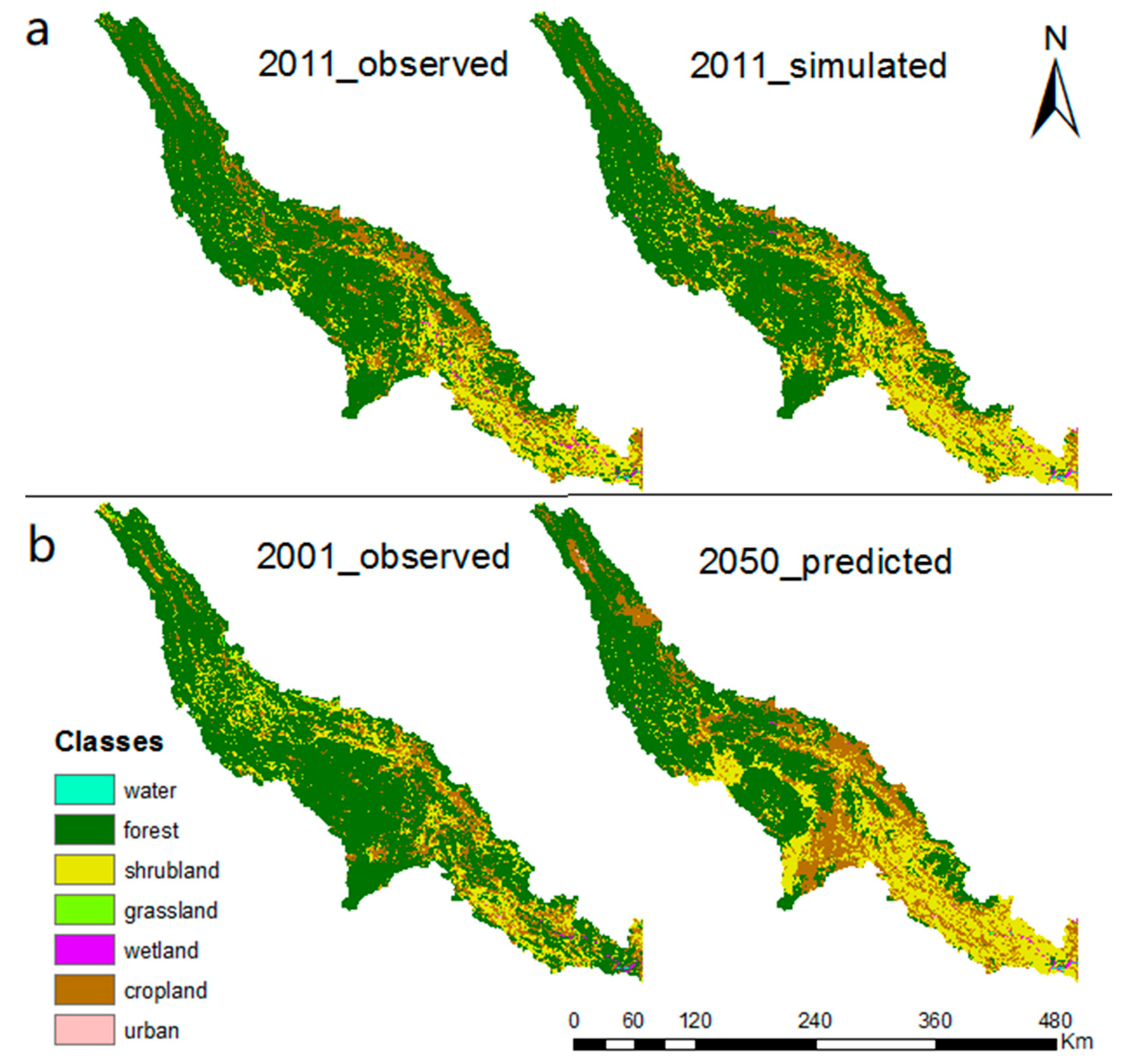
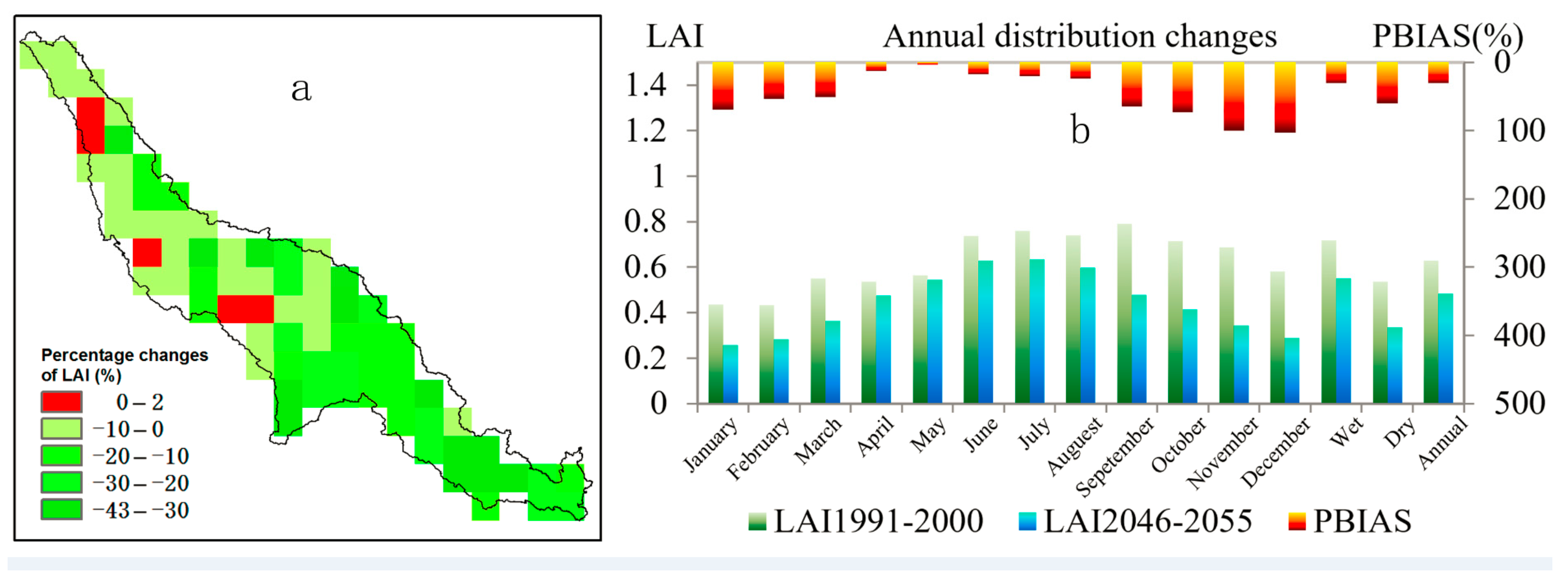
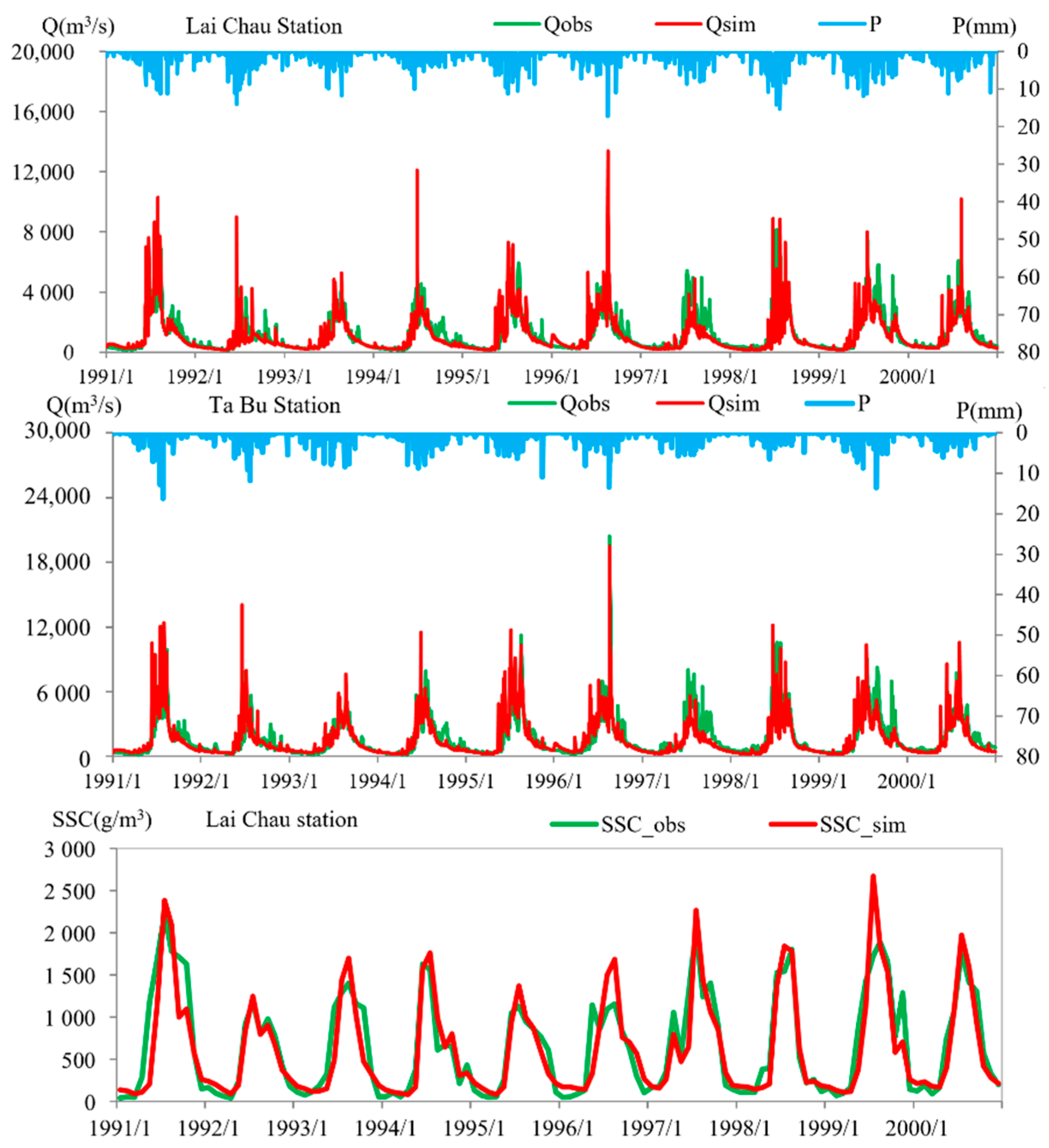

| Models | Spatial Dataset | Point Dataset |
|---|---|---|
| Hydrological model BTOPMC | Elevation, land cover, soil map, LAI | Rainfall, streamflow meteorological data (e.g., precipitation, maximum/minimum air temperature, vapor pressure) |
| New sediment rating curve NSRC | LAI | Streamflow, SSC |
| Land change model LCM | Elevation, land cover, soil map, population density, road and river networks, slope, human footprint, rainfall trends | |
| Ecological model Biome-BGC | Elevation, land cover, soil map | precipitation, mean air temperature, mean air temperature, vapor pressure |
| Land Cover | Reference 2011 (pix) | Simulated 2011 (pix) | Mean Error | Percent (%) | Kappa Index |
|---|---|---|---|---|---|
| Water | 869 | 842 | −27 | −3.1 | 0.94 |
| Forest | 184,701 | 177,657 | −7044 | −3.8 | |
| Shrublands | 60,433 | 69,411 | 8978 | 14.8 | |
| Grasslands | 10,743 | 9126 | −1617 | −15.0 | |
| Wetlands | 825 | 896 | 71 | 8.6 | |
| Croplands | 58,871 | 58,403 | −468 | −0.8 | |
| Urban | 1618 | 1725 | 107 | 6.6 |
| Land Cover | Baseline 2001 (%) | Predicted 2050 (%) | Changes (%) |
|---|---|---|---|
| Water | 0.06 | 0.05 | −0.01 |
| Forest | 70.91 | 49.57 | −21.34 |
| Shrublands | 15.5 | 25.47 | 9.97 |
| Grasslands | 0.72 | 0.16 | −0.56 |
| Wetlands | 0.19 | 0.34 | 0.15 |
| Croplands | 12.57 | 24.27 | 11.7 |
| Urban | 0.06 | 0.14 | 0.08 |
| Streamflow | SSC | |||||
|---|---|---|---|---|---|---|
| Lai Chau | Ta Bu | Lai Chau | ||||
| Calibration | Validation | Calibration | Validation | Calibration | Validation | |
| NSE | 0.75 | 0.70 | 0.70 | 0.65 | 0.85 | 0.82 |
| RSR | 0.48 | 0.57 | 0.51 | 0.65 | 0.33 | 0.45 |
| PBIAS (%) | 6.2 | 7.2 | 7.0 | 7.8 | 0.53 | 1.22 |
| Catchment | Time Scale | P | AET | SR | GW | TR |
|---|---|---|---|---|---|---|
| LC | wet season | 2523.1 | 630.1→586.0 | 1343.3→1534.1 | 548.7→521.2 | 1892.0→2011.2 |
| (−7.0%) | (14.2%) | (−5.0%) | (6.3%) | |||
| dry season | 540.2 | 135.1→128.3 | 241.8→273.5 | 161.2→156.4 | 403.0→423.2 | |
| (−5.0%) | (13.1%) | (−2.9%) | (5.0%) | |||
| annual | 1608.5 | 401.1→377.1 | 832.1→940.3 | 373.9→358.9 | 1206.0→1275.9 | |
| (−6.0%) | (13.0%) | (−4.0%) | (5.8%) | |||
| TB | wet season | 3202.3 | 796.9→733.1 | 1706.1→1989.3 | 696.9→648.1 | 2403.0→2573.6 |
| (−8.0%) | (16.6%) | (−7.0%) | (7.1%) | |||
| dry season | 760.6 | 188.2→176.9 | 342.0→394.0 | 228.0→216.6 | 570.0→600.2 | |
| (−6.0%) | (15.2%) | (−5.0%) | (5.3%) | |||
| annual | 1989.1 | 495.3→460.7 | 1030.2→1192.9 | 462.8→435.1 | 1493.0→1593.0 | |
| (−7.0%) | (15.8%) | (−6.0%) | (6.7%) |
© 2018 by the authors. Licensee MDPI, Basel, Switzerland. This article is an open access article distributed under the terms and conditions of the Creative Commons Attribution (CC BY) license (http://creativecommons.org/licenses/by/4.0/).
Share and Cite
Wang, J.; Ning, S.; Khujanazarov, T. Modeling Hydrological Appraisal of Potential Land Cover Change and Vegetation Dynamics under Environmental Changes in a Forest Basin. Forests 2018, 9, 451. https://doi.org/10.3390/f9080451
Wang J, Ning S, Khujanazarov T. Modeling Hydrological Appraisal of Potential Land Cover Change and Vegetation Dynamics under Environmental Changes in a Forest Basin. Forests. 2018; 9(8):451. https://doi.org/10.3390/f9080451
Chicago/Turabian StyleWang, Jie, Shaowei Ning, and Timur Khujanazarov. 2018. "Modeling Hydrological Appraisal of Potential Land Cover Change and Vegetation Dynamics under Environmental Changes in a Forest Basin" Forests 9, no. 8: 451. https://doi.org/10.3390/f9080451
APA StyleWang, J., Ning, S., & Khujanazarov, T. (2018). Modeling Hydrological Appraisal of Potential Land Cover Change and Vegetation Dynamics under Environmental Changes in a Forest Basin. Forests, 9(8), 451. https://doi.org/10.3390/f9080451





